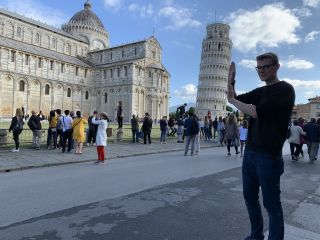Social Networking
The Behavior of Tourists at the Leaning Tower of Pisa
How do super weak relationships affect vacationers' behaviors?
Updated May 28, 2024 Reviewed by Abigail Fagan
When traveling to Europe, a visit to Italy is a must. One of the highlights of such a trip is Tuscany, and a visit to the beautiful city of Pisa is certainly on the itinerary. The main attraction in Pisa is the world-famous Leaning Tower.
Upon entering the area around the Leaning Tower, one immediately notices the peculiar behavior of other visitors. They comically contort their bodies, and it takes a moment to realize what they are doing.
The other tourists are taking pictures holding up the tower, making it appear as if they are preventing it from falling. Nearly everyone is doing this, and some seem to visit the site solely for this purpose. They compete for the best spot to capture such an image. As a visitor, this initially seems peculiar, but soon the idea of doing the same and taking such a picture of every fellow traveler arises.
Cooperation among travelers
To capture the right perspective, one needs another person to correctly align the camera and provide some directions, like "move slightly to the left; can you lean your upper body forward a bit more..." I wondered how this synchronization of behavior arises and what factors play a role in it.

The most important point is something that has affected everyone. We have seen others and have been influenced by them. After understanding what the other people are doing, we also want to have such a witty and ironic picture. Hence, we simply imitate the behavior of others. This seems natural, especially since the pictures we take this way are not just for ourselves. We immediately decide to send the funny picture to our loved ones back home. Others may also post the picture on social media to share their experience with their followers.
Super weak ties connecting unfamiliar individuals
The behavior at the site itself is nothing out of the ordinary because almost everyone practices it. However, back home, where most people are not familiar with it, others perceive it as an interesting idea and thus participate in the great journey. So, the behavior thrives on relationships: There is the relationship with the person taking the photo, who is usually a fellow traveler, someone we have a strong bond with. Then there are those to whom we send the photos, who are likely to be friends or relatives. On social media, however, the majority are weak connections with whom we share something about our journey. Most important for the situation at the Leaning Tower are the relationships with those with whom we do not have such a traditional bond. It is a purely observational relationship that causes us to be socially influenced and adopt their behavior. I refer to such relationships as Super Weak Ties. It is a relationship that transcends traditional cultural boundaries.
All are equal, but some are immune
Practically everyone at the site is equal, regardless of whether they come from — Asia, America, or Europe. Wait, are they really all the same? No, of course not: The locals, the people of Pisa, do not engage in the same behavior; they are immune to the influence! They perceive the behavior of tourists at best as peculiar. Thus, the influence does not work equally for everyone. One could say that there are structural differences between the two groups, the locals and the tourists. Tourists usually visit the site only once and are therefore compelled to seize the opportunity for a photo. The locals are already familiar with the scene and associate it with something else. Perhaps they are running errands or visiting someone they know. They have different connections to the place and the other people there. One would say that this makes the locals maintain their own kind of relationships with each other, making them immune to the influence of visitors. Tourists, on the other hand, are all there for the same reason and arrive alone or in their groups. Therefore, they are much more susceptible to being influenced.
The spread of imitating others also involves another factor: competition. Some authors, like Pierre Bourdieu, describe this as "distinction," while Harrison White refers to it as the "pecking order" phenomenon. There is a dynamic at play in addition to competition for the best spot for the picture. There is also variation in how the image is presented. Often, it's a competition within the group rather than with others in the square. For instance, people take pictures of someone leaning against the tower or symbolically trying to kick it over with their foot.
The impact of social media
One question remains: Do people come up with the idea of taking a funny photo each day, which other tourists then copy? In other words, is the tower-holding pose reinvented daily and then imitated by others? No, this is not the case, as it is already a well-known image that has been widely shared on social media. For instance, if you search for Pisa on Instagram, you will quickly find tower-holding pictures like this. Many people simply recreate images they have seen before their trip. In essence, they connect themselves to distant people or objects they have created. This also happens to people who have previously visited the place. An anonymous search reveals the photos, indicating that weak connections can transmit the behavior.
Do super weak ties also explain over-tourism?
When these pictures become ubiquitous, i.e., widely known, the situation may even be reversed: It is no longer about an original funny picture; instead, people virtually expect a tower-holding picture to be sent to them as well. What happens in this case is that a local culture develops, greatly influencing people's behavior and transmitted through weak relationships. This is particularly common in the tourism sector, where the effects include complaints about over-tourism, especially in places where a particular photo has become popular through social media. These weak ties could even play a role in explaining over-tourism hot spots. I cover more about the effects of weak ties in my book, Weak Ties: What Holds Our Society Together.
References
Bourdieu, Pierre (1984): Distinction. A Social Critique of the Judgement of Taste. Cambridge, Mass: Harvard University Press.
Stegbauer, Christian (2024): Super Weak Ties. What Culturally Holds our Society Together. Wiesbaden: Springer.
White, Harrison C. (1992): Identity and control. A structural theory of social action. Princeton NJ: Princeton Univ. Press.


